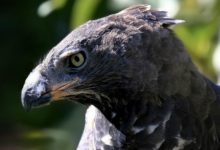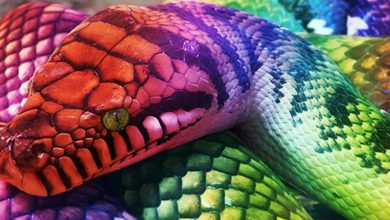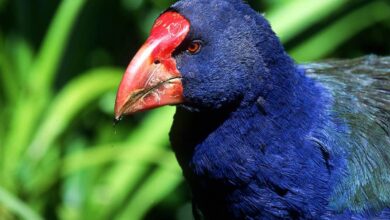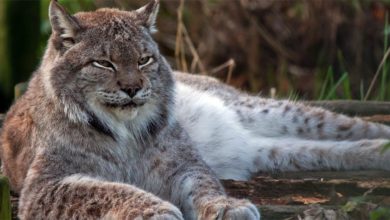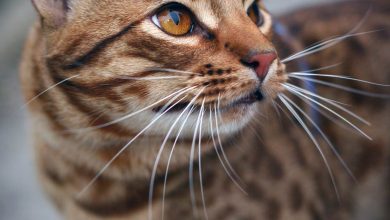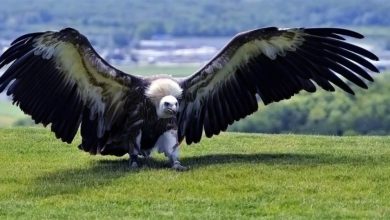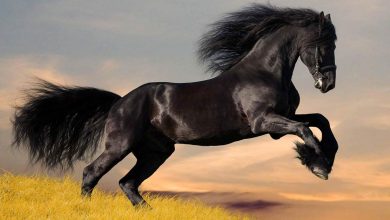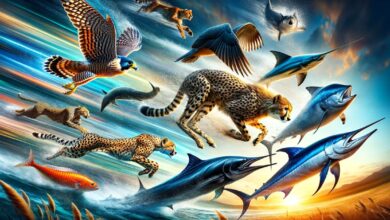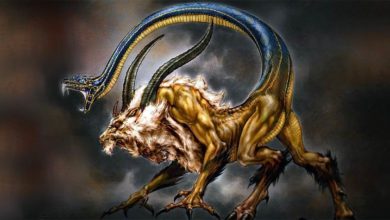Sarcosuchus – SuperCroc
Sarcosuchus – SuperCroc
As we know, the first crocodiles appeared 228 million years ago, in the Triassic Period (Mesozoic Era). Creatures considered crocodiles, apart from the present-day animals of this superorder, traditionally include all extinct Crocodylomorpha reptiles. One of the largest and best-known reptiles, related to present-day crocodiles was the Sarcosuchus, living in the Early Cretaceous epoch, 112 million years ago. The Sarcosuchus belongs to the Crocodylomorpha superorder, as well as the present-day crocodiles, yet it is not their direct ancestor. However, let’s leave the detailed discussions about the classification to the enthusiasts and get to the point 🙂
Introduction
In the vast and treacherous landscape of prehistoric Earth, one creature stood out as an apex predator like no other. It was a colossal beast that dwarfed even the mightiest of dinosaurs, with a bite force that could crush bone and a body that could reach up to 12 metres (39 feet) in length. This creature was the Sarcosuchus, known colloquially as the SuperCroc.
The SuperCroc roamed the earth over 100 million years ago during the Cretaceous Period, and was one of the largest crocodiles to ever exist. Its name comes from the Greek words “sarco,” meaning flesh, and “suchus,” meaning crocodile, which accurately describes its massive size and ferocity. While the modern-day crocodile is certainly no slouch in terms of power and adaptability, the SuperCroc was truly a force to be reckoned with.
What made the SuperCroc so fearsome was not just its size, but its unique physiology. It had a long, narrow snout filled with sharp teeth that could clamp down with incredible force, allowing it to catch and kill prey much larger than itself. Its body was also adapted for aquatic hunting, with powerful limbs and a muscular tail that propelled it through the water at impressive speeds.
But what really sets the SuperCroc apart from its modern-day counterparts is its sheer size. While the largest crocodiles today can reach up to 23 feet in length, the SuperCroc could grow up to 39 feet long and weigh as much as 8 metric tons. That’s roughly the weight of two adult elephants! It’s hard to imagine what it would have been like to encounter such a creature in the wild, but one can only assume it was a truly awe-inspiring sight.
Despite its impressive size and power, the SuperCroc eventually went extinct along with the dinosaurs at the end of the Cretaceous Period. But its legacy lives on, as scientists continue to study its remains and learn more about the fascinating world of prehistoric crocodiles. Who knows what other incredible creatures are waiting to be discovered in the fossil record – but for now, the SuperCroc remains one of the most incredible and awe-inspiring animals to have ever existed.
Sarcosuchus – 12 meters of length, 8 tons of weight, 132 teeth – Ladies and Gentlemen, here is true natural-born killer.
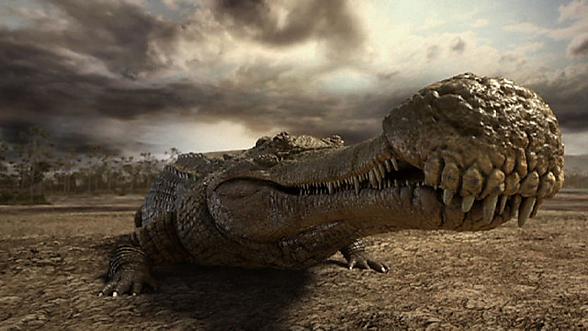
Discovery
Sarcosuchus was not known until very recently but only from a few teeth fossils and scales which were found in the Sahara desert by a French paleontologist Albert-Félix de Lapparent in the year 1940 or 1950.
In the years 1997 and 2000, an American paleontologist Paul Sereno discovered several unknown specimens, including one that was preserved almost half-completely, even the spine. Every other gigantic crocodylomorph is known merely by a few incomplete skull fossils, which stresses the question – which one was indeed of the largest size.
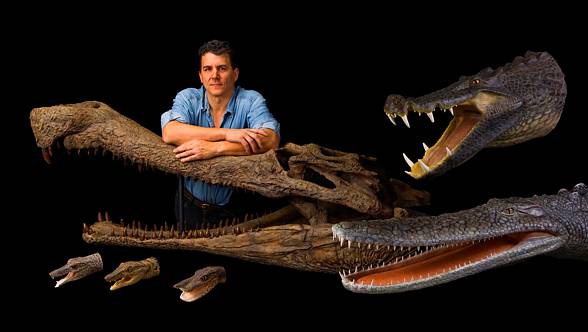
Name
Sarcosuchus – commonly referred to as SuperCroc, while really its name literally means… an overweight crocodile.
Sarcosuchus – snout
The Sarcosuchus, or alternatively, SuperCroc, apart from its great general size, also had a massive skull and jaws. However, as a matter of fact, it was relatively narrow, contrary to the prehistoric alligator – Deinosuchus.
The skull was about 1.78 meters long (5ft 10in), 1.3 m (4ft 3in) of which were jaws, which held 132 teeth, growing back over its whole lifetime. Unsurprisingly, it was not bothered by their loss, and unlike us, it did not have to make dental appointments, brr. By the way – its teeth actually were not so sharp. It had exceptionally strong jaws instead.
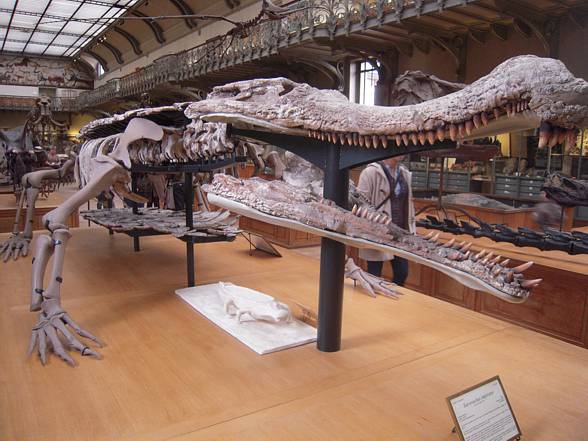
Sarcosuchus – bite force stronger than T. rex?
Dr. Greg M. Erickson from Florida State University has estimated the prehistoric crocodiles’ bite force based on the present-day animal data. His estimates claim that the Sarcosuchus bite force could reach 80 kN, which is equivalent to about 8 tons of force, while the Deinosuchus could reach 10.5 tons/cm2 (23 100 lbs)! According to his research, the saltwater crocodile has a larger bite force (1.68 tons/cm2) than the commonly favored American alligator (964 kg).
Was that the true state of affairs, or was it only the pursuit of prestige and extrapolation took one step too far? We may only leave those questions pending an unequivocal answer.
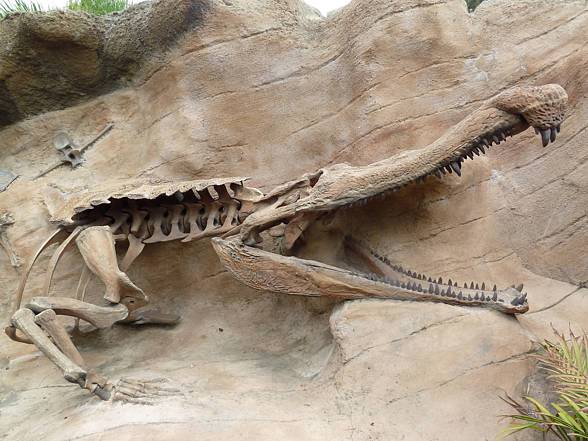
Diet and prey
Although Sarcosuchus’ immense size and great bite force, it mostly ate fish (unlike the Deinosuchus or Rhamphosuchus) as well as the famous Spinosaurus. Paleontologists claim that adult crocodiles could also hunt for tortoises as well as small dinosaurs at the watering place. On such occasions, the enormous jaws were used to immobilize the victim, drag it into the water, and shred to pieces – not to bite or chew.
However, some biologists claim that its capability of killing larger prey are overestimated, as it could be compared to a bigger version of the present-day gavial as well as the Rhamphosuchus. Nevertheless, the dispute remains unsettled.
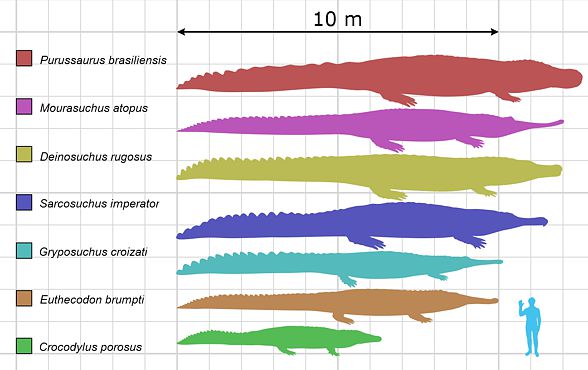
Sarcosuchus was growing throughout its life
As well as the present-day crocodiles and snakes (see: Anaconda, Python), Sarcosuchus grew in a constant manner throughout its whole life (this was established through comparison of fossil bone sections found by paleontologists). As a result, the longest and oldest Sarcosuchus crocodiles reached 12 meters of length, being twice as long as the longest present-day crocodiles. Their weight was almost 10 times as large.
Size
As no complete skeleton was found yet, the size of Sarcosuchus was estimated based on the size of present-day crocodiles.
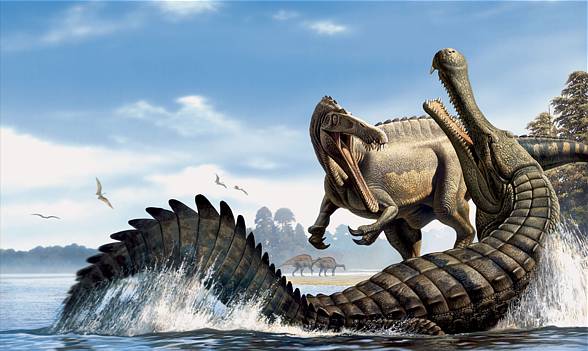
Sarcosuchus – eyes
Much can be said about the everyday habits of an animal by the analysis of the shape and structure of its eyes. Sarcosuchus did not move its eyes around horizontally, rather vertically. Most likely it spent most of the time submerged in the river waters, seeking potential prey.
Sarcosuchus – tail
Sarcosuchus had a powerful tail, which served as a fish caudal fin. It moved it horizontally, generating a tremendous drive force, which allowed it to reach velocities in the water sufficient to hunt for fast-moving fish. The tail power was so immense that the Sarcosuchus could ‘leap’ out of the water to catch a potential victim at the watering place.
Where did Sarcosuchus live?
Sarcosuchus inhabited North Africa. 100 million years ago, when North Africa was a green, tropical region covered with a dense network of rivers and streams. Relatively recently (in terms of geological periods :)) this area transformed into a Sahara desert. Sarcosuchus was one of many giant reptiles that benefited from the abundance of this continent.
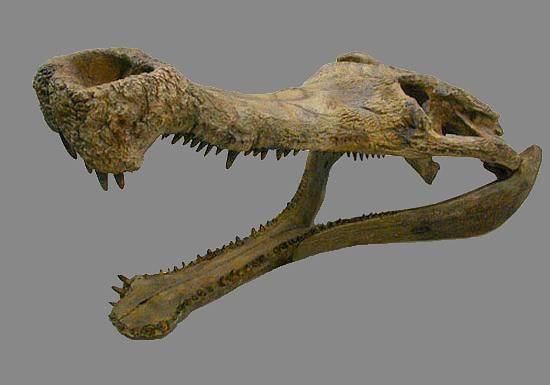
Detailed characteristics / size
Sarcosuchus
- Length: 11 – 12 m (36–39 feet)
- Skull length: 178 cm (5 ft 10 in), as long as the skull of a Spinosaurus or Giganotosaurus
- Weight: 8 tons
- Lifespan: 50 – 60 years
- Bite force: 80 000 N / (18,000 lbf) / 8 tons (?) – that would make its jaws stronger than a T. rex.
Occurrence
- Early Cretaceous: 133-112 (93.5) million years ago
- Africa
- Freshwater
Classification
- Kingdom: Animalia
- Phylum: Chordata
- Class: Reptilia
- Superorder: Crocodylomorpha
- Family: †Pholidosauridae
- Genus: †Sarcosuchus
- Species: Sarcosuchus imperator and Sarcosuchus hartii
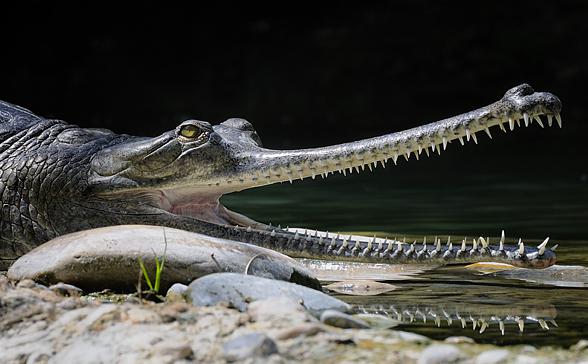
Sarcosuchus vs Saurosuchus
Please do not confuse the Saurosuchus with the Sarcosuchus 🙂 Although the names are similar in sound, both reptiles are more than 100 million years apart, they also appeared on different continents. Each of them belongs to a different family.
Sarcosuchus – interesting facts
- A full-sized cast of a Sarcosuchus skull (more precisely Sarcosuchus imperator) can be seen in the Museum of Evolution of the Polish Academy of Sciences in Warsaw.
- Sarcosuchus was a Crocodyliformes but not a member of Eusuchia
- Sarcosuchus was first discovered in 1946 by French paleontologist Albert-Félix de Lapparent and his team. They found fossils of the animal in the Sahara Desert in what is now Niger.
- Sarcosuchus is often referred to as a “crocodile”, but it was actually a type of prehistoric crocodilian, which is an extinct group of reptiles that were related to modern-day crocodiles.
- Sarcosuchus had one of the most powerful bites of any animal that ever lived.
- The teeth of Sarcosuchus were cone-shaped and designed for gripping and tearing flesh. Some of its teeth were over 6 inches long!
- Despite its massive size, Sarcosuchus was a surprisingly agile swimmer. Its long, muscular tail and powerful legs allowed it to move quickly through the water.
- Sarcosuchus likely fed on a variety of animals, including fish, turtles, and other small reptiles. It may have also hunted larger dinosaurs that came to drink at rivers or lakes.
- Sarcosuchus is sometimes called the “SuperCroc” because of its enormous size and strength. However, it’s important to note that it was not a true crocodile, but rather a distant relative.
- Scientists believe that Sarcosuchus went extinct around 93.5 million years ago, possibly due to changes in the environment or competition with other predators.
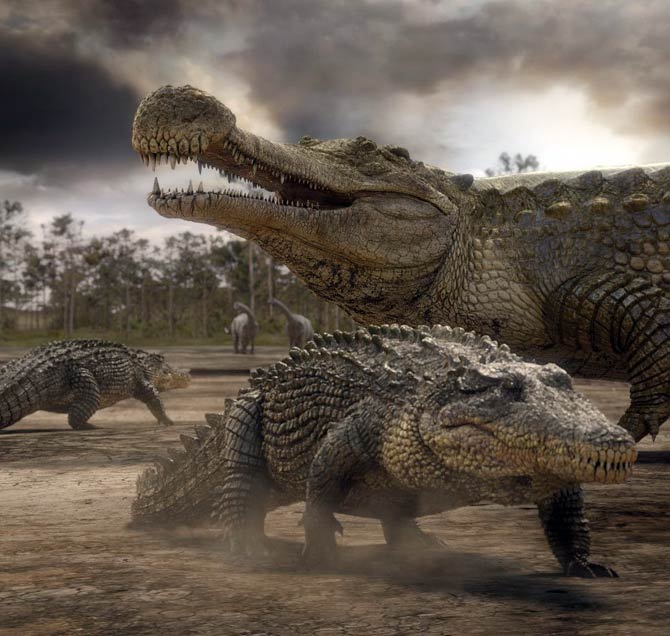
Recommended
- Animals records
- Extinct animals
- Deinosuchus
- Rhamphosuchus
- Largest crocodiles Top 10
- Gigantopithecus
- Megafauna
- Titanoboa
- Megalodon
- American lion
- Cave lion
- Smilodon
- Largest eagles Top10
- Largest birds of prey
- Fastest animals – Top 10
- Fastest birds – Top 10
- Most venomous snakes – Top 10
- Largest sharks Top 10
- Heaviest land animals
- Largest whales TOP 10
- Longest snakes Top 10
- Highest (Top) flying birds – Top 10
- Largest and heaviest birds
- Largest turtles TOP 10





